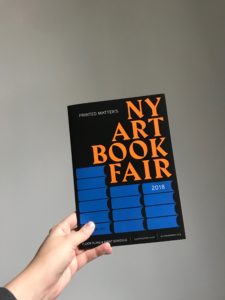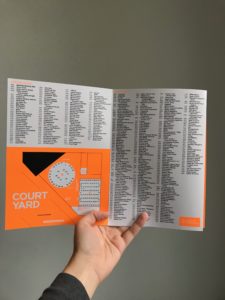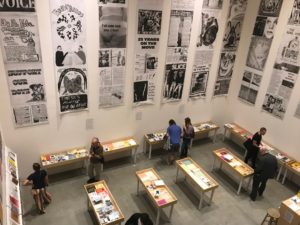I attended the MoMA PS1’s Art Book Fair on September 21st for my INFO 601-04 event review. While museums are often male and white-centric spaces, the Art Book Fair showcases voices in art and publishing who are often marginalized with one of the most important contemporary art museums as the backdrop. The Art Book Fair is hosted by Printed Matters, a non-profit publishing house who features zines, artists books, posters, and out-of-print material in their repertoire. Although Printed Matters is the headlining host, it is only one of nearly 365 exhibitors which includes small independent publishers, artists, collectives, and illustrators. The Art Book Fair is an event I look forward to every year, and is one of the only major art events that is free and open to the public. As I attended on the first official day, the entire Fair seemed to be buzzing with excitement for the weekend ahead. The tents and galleries were filled with attendees and exhibitors engaging in conversation.

Brochure listing exhibitors
One of my favorite parts of this year’s event was the selection of fair-specific installations. These exhibitions included promotional displays for galleries and presentations of historical materials. In many cases, these exhibitions included space to purchase books and other promotional materials of the artists, publishers, and galleries, but mainly these were traditional gallery spaces.
One of my favorite installations was a History of Zines!. This was an exhibition detailing the historical background of zines started with underground cultural and science-fictions publications from the 1920s and continued until present-day. The present-day zines were made specifically for the Fair. Zines have long been the format used by counter-cultural movements, including feminist activists, indigenous groups, punk movements, persons of color, etc. Cheap and easily reproduced, zines have become the main format activists have chosen to relay their messages. I’m glad the fair decided to highlight the history behind zines as many of the exhibitors featured continue to use the zine format to showcase their work. In fact, the Art Fair’s biggest tent is dubbed the Zine Tent as many prominent art collectives and zine creators exhibit in this space.
History of Zines! exhibition area
Another installation I found very compelling was hosted by Martos Gallery which included selected works and notebooks of the artist Dan Asher. Martos Gallery photocopied Asher’s notebooks and made the pages into floor-to-ceiling wallpaper. Many visitors, myself included, spent an extended period of time pouring each page. Asher’s notebooks included diary entries, addresses of clients and friends, musings, and plans for future pieces. This was an interesting way to exhibit archival materials side-by-side with finished art pieces, giving a glimpse into the process of the artist. This was a great choice in the context of the Art Fair, where visitors can speak to the artists and collectives who create work they enjoy in-person.
Notebook wallpaper from Martos Gallery exhibit
Events like the Art Book Fair are important, because they allow for the “knowledge and particular needs of communities” to be illustrated and exhibited in contexts or environments traditionally barred to them (Stevens, 2008). It gives MoMA PS1 an opportunity to be actively engaged with queer, POC, and indigenous communities, and taking the museum off its pedestal. The Art Fair is a necessary step in ushering in more inclusive and intersectional art spaces where all voices feel welcomed and represented.
Conclusions
As an information professional who is interested in creating accessible museum spaces, I believe engaging in the Art Fair is the first step towards creating a more inclusive information community. I think it is also important to urge other information professionals (librarians, curators, archivists) to also attend this event for themselves. I will try to make a conscious effort to seek out similarly inclusive art, publishing, and information events in the future as I gain more footing in my own information profession.

